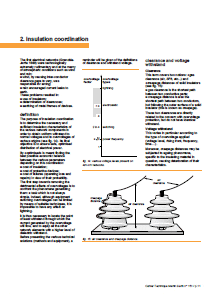Protection of persons and equipment
Insulation coordination is a discipline aiming at achieving the best possible technico-economic compromise for protection of persons and equipment against overvoltages, whether caused by the network or lightning, occurring on electrical installations. It helps ensure a high degree of availability of electrical power. Its value is doubled by the fact that it concerns high voltage networks. To control insulation coordination:
- the level of the possible overvoltages occurring on the network must be known;
- the right protective devices must be used when necessary;
- the correct overvoltage withstand level must be chosen for the various network components from among the insulating voltages satisfying the particular constraints.
The purpose of this “Cahier Technique” is to further knowledge of voltage disturbances, how they can be limited and the standards to ensure safe, optimised distribution of electrical power by means of insulation coordination. It deals mainly with MV and HV.
Overvoltages
These are disturbances superimposed on circuit rated voltage. They may occur:
- between different phases or circuits. They are said to be differential mode;
- between live conductors and the frame or earth. They are said to be common mode.
Their varied and random nature makes them hard to characterise, allowing only a statistical approach to their duration, amplitudes and effects. The table in figure 1 presents the main characteristics of these disturbances. In point of fact, the main risks are malfunctions, destruction of the equipment and, consequently, lack of continuity of service. These effects may occur on the installations of both energy distributors and users. Disturbances may result in:
- short disconnections (automatic reclosing on MV public distribution networks by overhead lines);
- long disconnections (intervention for changing damaged insulators or even replacement of equipment).
Protective devices limit these risks. Their use calls for careful drawing up of consistent insulation and protection levels. For this, prior understanding of the various types of overvoltages is vital: such is the purpose of this chapter.
AUTHOR: Schneider Electric expert | D. FULCHIRON
| Title: | Overvoltages and insulation coordination in MV and HV |
| Format: | |
| Size: | 0.2MB |
| Pages: | 24 |
| Download: | Right here | Video Courses | Membership | Download Updates |


